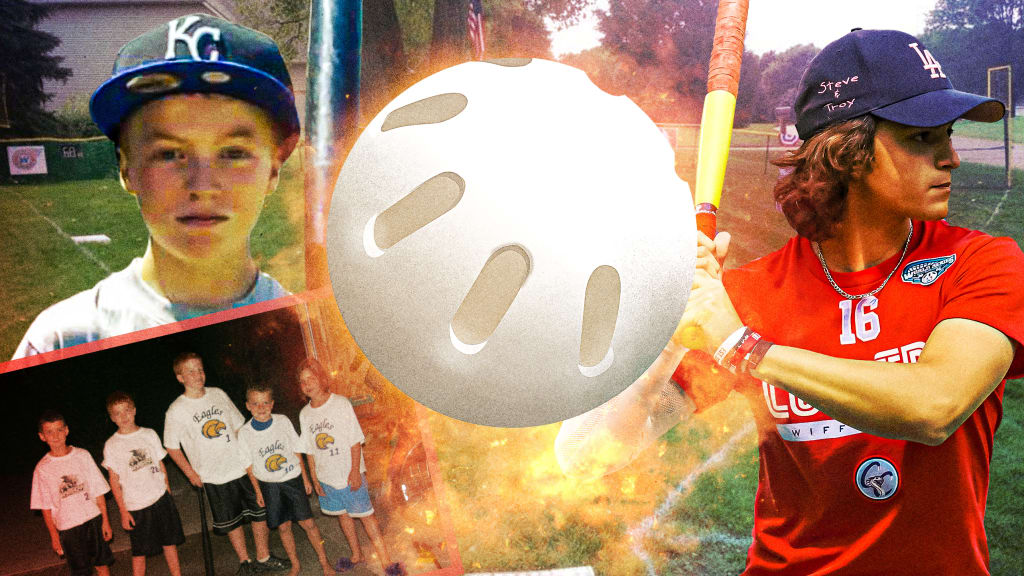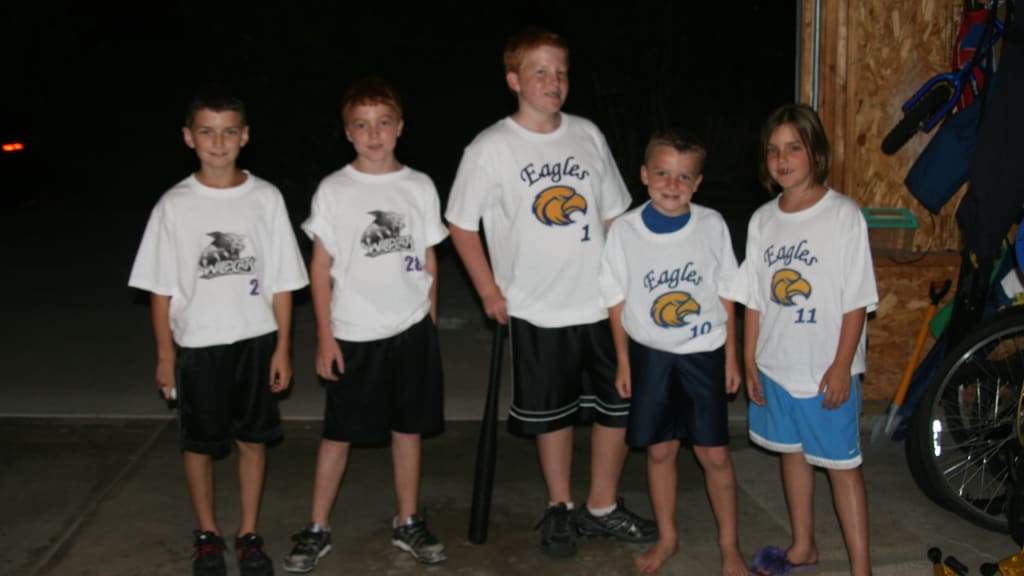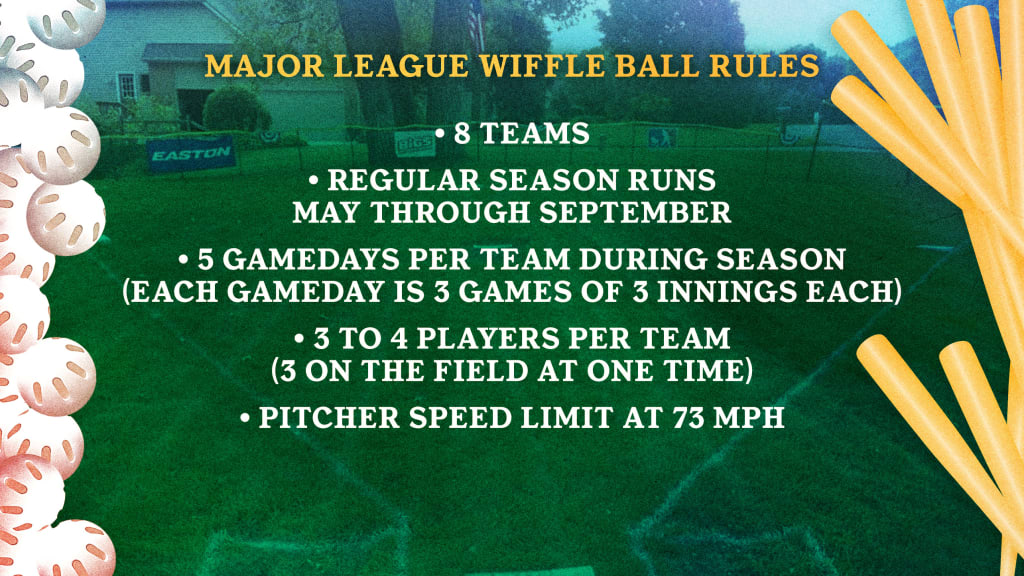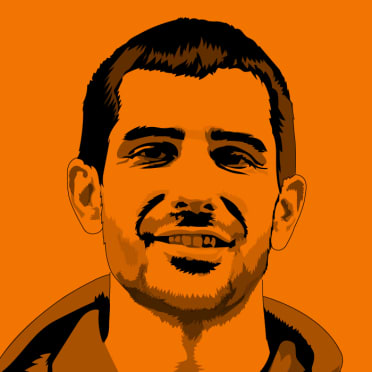
Back in 2009, on a hot summer day in Brighton, Mich., Kyle Schultz was doing something many of us probably grew up doing as kids.
He gathered up some neighborhood friends, grabbed a yellow plastic bat and white ball, set up a makeshift field in his front yard and played until it got dark outside. Until the sun dipped back below the sky. Until Schultz's parents yelled at him that it was time to come home.
"It was just like any other kid," Schultz, now 23, told me in a Zoom call. "I wanna say 8, 9, 10 years old, just playing pickup wiffleball with my brothers and my neighbors in my front yard."
But unlike most of us, Schultz took his love affair for wiffleball to an entirely different level.
The next summer, he and his friends decided to create their own league: They'd have rules, different teams, a fence and, most importantly, video capturing every aspect of every season moving forward.
Today, Major League Wiffle Ball has over 350,000 subscribers and 54 million views on YouTube, along with 148,000 Instagram followers and 492,000 TikTok fans. Their 2022 World Series was played at the 70,000-seat SoFi Stadium in Los Angeles.
"You talk about moments where you thought you made it," Schultz said. "That one was crazy. We essentially had this whole stadium to film at. It was a mind-blowing experience, not just for me, but for all the guys who had been in the league for 10-plus years."
The road to SoFi was a long, constantly changing one for Schultz and his friends.
13 years ago, the crew started with a simple garden fence in the outfield and a golf swing net for a backstop (probably seems fairly high-tech for some of us who used their house chimney for a backstop and a neighbor's hedges as outfield boundaries). The strike-zone area was also pretty makeshift at the time.
"It was funny, for our very first strike zone in 2010, we used an art easel," Schultz laughed. "You know, one that a little kid would draw on and stuff."
Because Schultz and his crew have pretty much documented everything on the field since Day 1, fans can catch a glimpse of how it all looked at the very beginning -- right down to the low, no-audio video quality. It'll probably give you some nostalgic, feel-good memories of your own childhood wiffleball years.
"Calling it a league [in 2010] was pretty rough," Schultz said. "It was two teams. My team was me and my friend Tommy [Coughlin] and the other team, the Eagles, were my two brothers and Tommy's sister. So it was 2 v 3 basically every single game, consisting of two families that were pretty much next-door neighbors."

Cultz Field, named after the two families, was the home of MLW from 2010-17. Over the years, things progressed.
The kids pretended they were sponsored, printing out McDonald's and Under Armour signs to drape over the outfield fence. They had team shirts. Neighbors dropped by to see what all the fuss was about during those early summers, taking in the action from porch chairs propped off to the side of the diamond. The strike zone changed from an art easel to pvc pipes surrounding a leather pad. Schultz's parents consistently supported his habit, saying it was "better than playing video games."

"It was like every day, you play," Schultz told me, smiling as he sifted through the memories in his head. "You're too young to have a job, you're out of school, you go to as many summer camps as you can, but you have all that free time as a kid. Early middle-school, late elementary-school days. That's what you did; you played wiffleball, you played hide-and-seek and tag and all these types of things around the neighborhood. That was pretty much my entire childhood."
But what really helped grow the game and catapult MLW into the public sphere was the league's expert use of video and social media.
Music and instant replay ability were added. There were announcers and graphics. Montages of some of his pitchers' nastiest pitches went viral. When they moved to their current home in 2018 -- The Meadows -- a more professional (as professional as wiffleball can get) field was constructed.
With better quality video, views increased astronomically over the years. Schultz remembers thinking 1,000 views was a lot, but now many get near the one million range. More views meant more money to make the game videos, the jerseys, the merch and the promotion even better. It's a true cycle of success. Videos like the SoFi one above or the 2022 NLCS one below can give you a sense of how far they've come over the last almost decade-and-a-half.
"We are purely content-based," Schultz said. "We pride ourselves on our YouTube channel mainly. That's what people know us for, that's what we put most of our time and resources into. We've been posting our videos there since 2010, we haven't missed a single season. That's not gonna change. We love our YouTube channel, we love our YouTube community."
That community is vast -- top prospects like Josh Jung, who likely grew up watching MLW videos, will comment on their Instagrams. While doing exhibition tournaments in other cities (that's how they recruit new players), Schultz and his team will sometimes reach out to challenge MiLB or MLB players. They befuddled the Angels' Jo Adell and struck out All-Star James McCann.
"He didn't know how to hit a riser," Schultz laughed. "A riser is just foreign stuff to him and all the MLB guys."
The 23-year-old founder says one of his proudest moments had to be during last year's MLB playoffs -- when he and pitcher Jimmy Knorp went on TBS to talk about the league and strike out Jimmy Rollins and Curtis Granderson. They also taught Hall of Fame pitcher Pedro Martinez how to, well, pitch.
"It was the first time we got a taste of mainstream media," Schultz said. "Where they're actually talking about our brand and the story of it. You know, these MLB legends."
MLW's biggest fanbase, though, is among those who are actually out there playing wiffleball and watching YouTube: Pre-teens and teenagers. They're the ones commenting on Tik-Tok clips or sharing Instagram stories or out watching and cheering at these satellite tournaments.
"Seeing what we did at the Toledo Mud Hens stadium, we had like over 400-500 fans show up to a ... wiffleball game?" Schultz said, almost bewildered. "Still to this day, I can't even believe it. They were chanting our names and they knew all the players."
Schultz's goal is to keep touring around and hopefully play in more professional stadiums. He wants to make his league nationwide. He believes the growth of a 70-year-old game invented in a Connecticut backyard can help a pastime that's been around for nearly 150 years.
"I feel like the birth of loving baseball lies within wiffleball," Schultz said. "Before picking up a baseball bat, you're hitting a wiffleball with your parents at like the 4th of July campout or something. I think it's a great sport, there's a lot of history with it. Even now today, we get comments from people in their 50s, 60s and even older saying, 'I remember when me and my buddies were playing wiffleball and you remind me of us.'"
All photos via Kyle Schultz. Looking to form your own wiffleball league? Get a headstart here
